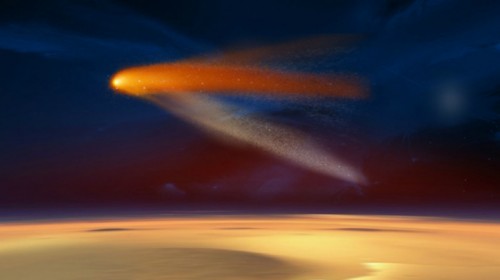An interesting comet will pass at 21:27 Israel time near the Red Planet * It will be possible to observe it with small telescopes and even binoculars but only from the southern hemisphere

On NASA's preparations from Mars, Earth and satellites, see the extension: NASA is geared up and ready for the Siding Spring comet pass by Mars this evening
Comet Siding Spring was discovered less than two years ago, and tonight (19.10.14) at 21:27 Israel time it is about to make history, and pass very close to Mars. More precisely, he is about to make history as far as short-lived guests like us, whose entire recorded history is but a cosmic blink of an eye. For him? It is just another visit to the Sun's environment, as it does every few million years, probably since before the Earth was formed.
A historical window
Comets are clumps of ice and dust that move in a huge and highly elliptical orbit around the Sun. As they approach it and heat up, the melting ice and the released dust cause them to create a kind of gaseous atmosphere around them, leaving behind a glowing trail of thousands of kilometers. But aside from the majestic appearance, the researchers hope that the close look at the comet will open a window to the processes of the beginning of the solar system, and perhaps help explain why certain bodies were able to form planets, while others were thrown into different orbits. "If we study the comet and study its composition and structure, we may learn a lot about how the planets were formed," explains Prof. Kerry Lisse from Johns Hopkins University, the partner in the study of comets at the American space agency. "It is also important to note that all of NASA's comet research in the past focused on comets that formed in the Kuiper belt, the asteroid belt beyond the orbit of Neptune, and not on comets like Siding Spring that formed in the Oort cloud - which is much more distant. With the missiles we have now we cannot reach the comets of the Oort cloud, their orbits are far too distant and fast. This comet comes to us where we will come to, and gives us a free observation. It's a great event for us", he concludes.
A closer look
Siding Spring, named after the observatory in Australia where it was detected, will pass this evening at a distance of only about 130,000 km from Mars (the comet will reach its closest point at 21:28 Israel time). From Earth it will be possible to distinguish it with telescopes, and even field binoculars, but only from the southern hemisphere. However, as far as the astrophysicists are concerned, the rare event occurs when they have front row tickets: no less than five satellites are currently orbiting Mars, three of NASA, one of the European Space Agency and one of India. The observation celebration will also be joined by the two American all-terrain vehicles on the surface of Mars, Opportunity and Curiosity, which will try to record the event with their cameras. The satellites, by the way, are supposed to fly to the other side of Mars immediately after the event, fearing that the heavy dust will harm their instruments, but we hope they will provide adequate observations.
Warm-up show
And while Siding Spring will pass him by, comet fans can expect another celebration in a few weeks, when the European Space Agency will launch the Philae lander from the Rosetta spacecraft, for the first ever attempt to land on a comet, Churyomov Gerasimenko. The landing site on the comet has already been selected, and the mother spacecraft is currently completing the final maneuvers and tests in preparation for the launch of the lander, scheduled for November 14.11. This complex operation is supposed to be carried out about 700 million km from Earth, and if it succeeds, our knowledge of comets will increase immeasurably, and may shed additional light on the history of our Earth as well.
In the same topic on the science website:
The landing site of the Paley lander (attached to the Rosetta spacecraft) on the comet has been determined
